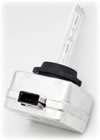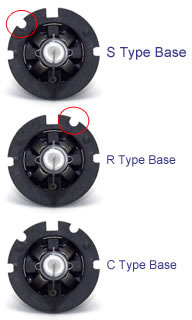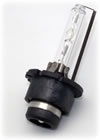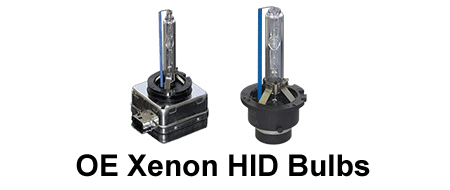Upgrade with Lumens Factory OE Replacement / Upgrade Xenon HID Bulbs
Lumens offers OE (aka factory style, original manufacturers equipment, stock) replacement Xenon HID bulbs. There are many advantages of choosing Lumens over the competition. We take extra care in the quality of workmanship and components that go into our products. At the same time, we realize that prices need to be reasonable and affordable to the consumer. Electrically and physically, these bulbs are built to the original specifications of the original bulbs. The only difference you will find is the color and type of light output from the bulb (should you decide to stray away from OE colors). The bulbs determines the color of light produced; the ballast only produces power for the bulb and does not influence the color output.

Color Temperatures (K - Kelvins)
There is a general misconception that a higher K rating provides more light than a lower K rating with Xenon HID lights. The brightest light is actually at a pure white light without any additional colors. With Lumens Xenon HIDs, you would see pure white at 6000K. OE manufacturers choose a light at 4300K rather than 6000K. 4300K has a slight yellowish color (like the color halogen bulbs have). This is not the brightest color band for a clear night; 6000K would provide more visibility in this case. Unfortunately, pure white light does have its downfalls. Because of its intensity, white light (6000K) also refracts back at the driver the most when there are particles in the air (ie. rain, snow, and fog). A less refractive light would be more useful in these conditions; we find yellow (3000K) to be the most effective in these situations. For OE manufacturers, they try to give the medium which would be between the white and the yellow for overall driving conditions.
For HID conversions on vehicles for daily driving (especially vehicles with projectors), we recommend the colors between 4300K - 6000K. Any colors below or above this range will result in loss of light (amount of light lost will vary depending on the housing / projector). For fog light applications, we recommend 3000K for performance in rain, snow, and fog.

Warning: Please use this color chart for reference only, as colors the users sees varies from monitor to monitor. Also, colors generated by the bulbs may appear differently inside different headlight housings / vehicles as the physical housings may influence the color / light amplification of the bulbs inside
 |
D1 and D3 bulbs: Aside from being just a bulb, these bulbs are easily distinguished by the metal box attached to the actual glass bulb itself. The metal box is an 'igniter' which is generally built as a seperate piece in D2 and D4 systems. These bulb types are much more expensive than its D2 / D4 counterparts for this reason (and also because the other bulb type is more common). There are 2 main differences between D1 and D3 bulbs. First is the voltage required to operate the bulb: D1 bulbs operate at 85V while D3 bulbs operate at 42V. Secondly, D3 bulbs are newer more environmentally friendly versions of D1 bulbs; D3 bulbs are mercury free. Because of these differences, D1 and D3 bulbs cannot be interchanged UNLESS their ballasts are replaced with the corresponding bulbs (you cannot mix components from 2 systems together). |
 |
 |
D2 and D4 bulbs: D2 bulbs are currently the most commonly found HID bulb used by manufacturers. Unlike the D1 and D3 bulbs, these bulbs do not have ignitors built on the bulb itself. The same differences between D1 and D3 bulbs are true for these bulbs. First is the voltage required to operate the bulb: D2 bulbs operate at 85V while D4 bulbs operate at 42V. Secondly, D4 bulbs are newer more environmentally friendly versions of D2 bulbs; D4 bulbs are mercury free.Because of these differences, D2 and D4 bulbs cannot be interchanged UNLESS their ballasts AND IGNITORS are replaced with the corresponding bulbs to create a full D2 OR D4 system (you cannot mix components from 2 systems together). |
|








